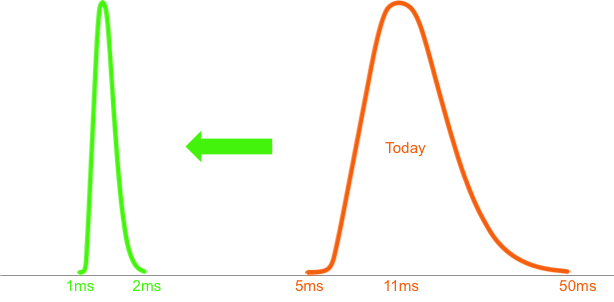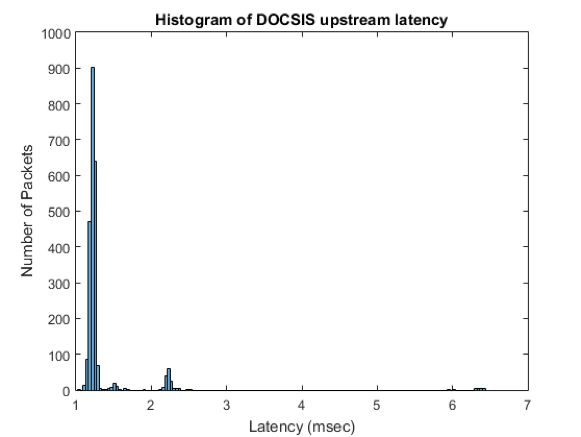DOCSIS
Enabling the Cable Networks for Mobile Backhaul

With 5G and small cell densification on the near horizon, mobile networks need economically viable backhaul solutions. Cable operators are well positioned with fixed networks to bridge that gap, and many operate mobile networks themselves. Could we be on the verge of fixed-mobile network convergence? Things seem to be pointing in that direction, but it won’t happen without technology developments to make DOCSIS and LTE networks compatible.
A big element of this compatibility is aligning the typical network latency between DOCSIS and what is required for backhauling LTE. Today’s DOCSIS upstream access latency is higher than the allocated budget (Fig 1) and solving the latency problem is key to enabling cable networks for mobile backhaul.

Fig 1. DOCSIS latency today, vs. where we want to get to
Our solution: together is better
About a year ago, a lightbulb moment led to a solution which led to a joint project between CableLabs and Cisco that I wrote about last October. You can read about it here.
To recap, instead of operating as two independent networks, we want to coordinate the DOCSIS channel access procedure with information made available by LTE, so that the DOCSIS process can start while the LTE transactions are still going on. When two systems work hand-in-hand, we achieve better end-to-end latency. (Fig 2)

Fig 2. Pipelining LTE and DOCSIS operations
With the CableLabs team supplying expertise in mobile and John Chapman’s (Cisco Fellow and CTO Cable Access) team developing the pipelining API on the CMTS, we jointly built a proof-of-concept (PoC) using open source LTE small cells and the Cisco cBR-8 CMTS.
What we have been working on
Since my blog last October, we have been working on characterizing DOCSIS latency with increasing load on the DOCSIS channel. Using the pipelining method, the series of ping packets we sent from the User Equipment (UE) achieved an upstream latency of ~1-2 ms on the DOCSIS link (Fig 3). The latency remained consistent when we loaded up the DOCSIS link with other upstream traffic of up to ~60% of the channel capacity. Above this loading point, the latency gain with our pipelining method became more significant compared to no pipelining, albeit creeping above the 1-2 ms range.

Fig 3. Ping packets achieved ~1-2 ms of upstream latency on the DOCSIS link
At this point, skeptical readers might be wondering, what’s the penalty for sending the LTE scheduling information across the DOCSIS link? We coded our LTE scheduler to send a “Bandwidth Report” (BWR) messages every 1 ms. A 80-byte BWR message, therefore, incurs 640 kbps, a minute amount compared to DOCSIS speeds that are now in the multi-Gbps range.
On the other hand, it is possible that the data predicted by the LTE scheduler might not actually arrive at the DOCSIS link, causing under-utilization of the DOCSIS grants. So, how many DOCSIS grants are issued by the CMTS but are not used with the BWR method? We performed tests and observed a respectable number. We will be reporting more on the upcoming webinar (details see below).
We have also been working on a fronthaul setup. Initial results showed that more latency gains can be expected with BWR compared to backhaul. More on that later.
What’s next
- We have been demonstrating the proof of concept to CableLabs members since last summer. CableLabs and Cisco will once again hold a joint demo at the upcoming Mobile World Congress.
- The joint team is wrapping up the PoC work. We worked together on perfecting the pipelining operation and designing the new BWR message. We will take this baseline design to the CableLabs Mobile Backhaul Working Group that I am currently leading. Given the interest from CableLabs members, my goal is to get LTE and CMTS vendors together to agree on protocol and message details, so that cable operators can get the latency benefit regardless of which LTE and CMTS equipment they choose to deploy.
- Additionally, in building the PoC, we have accumulated expertise on how to perfect the BWR algorithm to optimally predict the amount of data and time egressed from the LTE side. We will pass this knowledge on to the LTE implementers during the specification work.
I am holding a webinar with John Chapman on Thursday, February 15th at 8am Pacific / 11am Eastern / 5pm Central European Time. It is open to the public and we hope to see you there.
For those of you attending Mobile World Congress, I am holding a joint demo with John Chapman at the Cisco booth number 3E30, Hall 3 Hybrid Hall.

